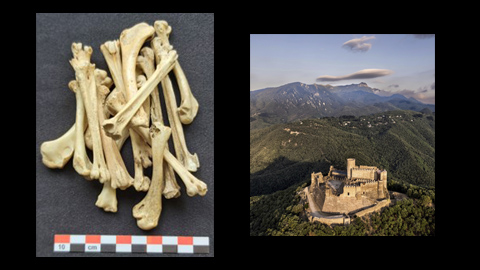A study including the involvement of the UAB has analysed the DNA of the remains of chickens from over 100 archaeological sites in Europe and the Middle East to trace the evolution of the Marek's disease virus during the past milennium. The findings show that ancient strains were less virulent than current ones and could serve to develop more efficient therapies for this devastating disease affecting poultry. The study was recently published in Science.

The study was led by researchers from the universities of Oxford and LMU Munich and involved a team of archaeologists and biologists, including Maria Saña, from the Department of Prehistory at the UAB.
Marek's disease (MDV) is caused by a herpesvirus that causes fatal infections in unvaccinated poultry, mainly chickens and hens, and costs more than a billion dollars a year to the poultry industry.
In the study, researchers reconstructed ancient MDV sequences from archaeological chickens and hens from the last thousand years. By comparing the viral genomes of modern and ancient birds, they identified the genetic alterations responsible for the increased virulence of the modern virus. In addition, based on the ancient genetic sequences, they were able to resurrect ancient biological processes through cellular assays, demonstrating that the ancient strains were significantly milder than their modern counterparts.
To carry out the study, researchers analysed DNA from chicken bones excavated from 140 archaeological sites in Europe and the Middle East. These ancient genomes revealed that the virus was widespread in European chickens at least 1,000 years before the disease was first described in 1907.
The site on the Iberian Peninsula that has been key to tracing this evolution is the castle of Montsoriu, located in the Catalan region of La Selva. In a cistern in the parade ground, a level of abandonment from the second half of the 16th century was documented, in which a set of 863 remains of chickens and hens were recovered during excavations led by the team of archaeologists from the Ethnological Museum of Montseny in the town of Arbúcies. These remains demonstrated that this species was an important food resource at that period of time.
"Being able to obtain valuable data on the evolution of the virulence of pathogens such as this one highlights the importance of all bioarchaeological remains found on the sites, since we cannot foresee how useful they may be in the future," says Maria Saña.
"Les troballes del nostre estudi no només desentranyen la història evolutiva del virus, també senten les bases per millorar la comprensió actual de la virulència del patogen. Combinant tècniques d'ADN antic amb la genòmica moderna hem obert una finestra al passat que pot orientar estratègies futures en la gestió de les malalties víriques", explica Steven Fiddaman, de la Universitat d'Oxford.
At the beginning of the 20th century, MDV caused only mild symptoms in older chickens. With the dramatic increase in consumption in the 1950s and 1960s, the virus continued to evolve and became increasingly aggressive despite the development of several vaccines.
"The findings of our study not only unravel the evolutionary history of the virus, they also lay the groundwork for improving the current understanding of the pathogen's virulence. By combining ancient DNA techniques with modern genomics, we have opened a window into the past that can guide future strategies in the management of viral diseases," explains Steven Fiddaman of the University of Oxford.
Article: Steven R. Fiddaman et al. Ancient chicken remains reveal the origins of virulence in Marek's disease virus. Science 382,1276-1281(2023). DOI:10.1126/science.adg2238






